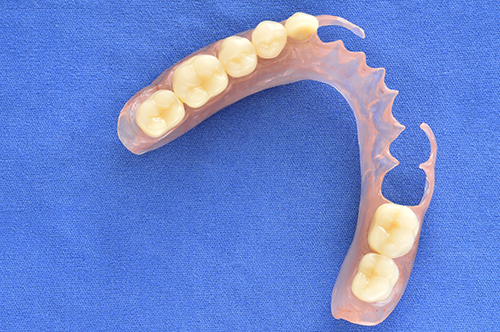ROCKY HILL DENTAL GROUP
Replacing Missing Teeth in Rocky Hill CT

About Removable Bridges in Rocky Hill CT
A removable bridge, more commonly known as a denture, is a removable replacement for missing teeth and adjacent tissues. It is made of acrylic resin, sometimes in combination with various metals.
Types of Dentures
Complete dentures replace all the teeth, while a partial denture fills in the spaces created by missing teeth and prevents other teeth from changing position.
Candidates for complete dentures have lost most or all of their teeth. A partial denture is suitable for those who have some natural teeth remaining. A denture improves chewing ability and speech, and provides support for facial muscles. It will greatly enhance the facial appearance and smile.
Complete or full dentures are made when all of your natural teeth are missing. You can have a full denture on your upper or lower jaw, or both.
Complete dentures are called “conventional” or “immediate” according to when they are made and when they are inserted into the mouth. Immediate dentures are inserted immediately after the removal of the remaining teeth. To make this possible, the dentist takes measurements and makes the models of the patient`s jaws during a preliminary visit.
An advantage of immediate dentures is that the wearer does not have to be without teeth during the healing period. However, bones and gums can shrink over time, especially during the period of healing in the first six months after the removal of teeth. When gums shrink, immediate dentures may require rebasing or relining to fit properly. A conventional denture can then be made once the tissues have healed. Healing may take at least 6-8 weeks.
An overdenture is a removable denture that fits over a small number of remaining natural teeth or implants. The natural teeth must be prepared to provide stability and support for the denture.
Partial dentures are often a solution when several teeth are missing.
How are dentures made?
The denture process takes about one month and five appointments: the initial diagnosis is made; an impression and a wax bite are made to determine vertical dimensions and proper jaw position; a “try-in” is placed to assure proper color, shape and fit; and the patient`s final denture is placed, following any minor adjustments.
Getting used to your denture
For the first few weeks, a new denture may feel awkward or bulky. However, your mouth will eventually become accustomed to wearing it. Inserting and removing the denture will require some practice.
Start out by eating soft foods that are cut into small pieces. Chew on both sides of the mouth to keep even pressure on the denture. Avoid sticky or hard foods, including gum. You may want to avoid chewing gum while you adjust to the denture.
Adjustments
If your denture no longer fits properly, if it breaks, cracks or chips, or if one of the teeth becomes loose, see your dentist immediately. In many cases, dentists can make necessary adjustments or repairs, often on the same day. Complicated repairs may require that the denture be sent to a special dental laboratory.
Denture adhesives
Denture adhesives can provide additional retention for well-fitting dentures. Denture adhesives are not the solution for old, ill-fitting dentures. A poorly fitting denture, which uses constant irritation over a long period, may contribute to the development of sores. These dentures may need a reline or need to be replaced. If your dentures begin to feel loose or cause pronounced discomfort, consult with your dentist immediately.
About Fixed Bridges in Rocky Hill CT
- A fixed bridge replaces a missing tooth or teeth. It is called a fixed bridge because it is not removable.
- A bridge is a structure, supported by teeth on either side of a space.
It spans the gap between teeth, just as a bridge spans a river.
How is a bridge made?
- The first step is to prepare the supports for the bridge.
- Replacement crowns are placed over existing teeth as supports for a bridge.
- The dentist pares down the teeth on either side of the gap, and takes an impression of the prepared teeth.
- This is then sent to the dental technician where the bridge is made.
- The technician will make a replacement crown for each prepared tooth.
- These crowns are joined to an artificial tooth, which replaces the missing tooth.
- The dentist will then cement the completed bridge over the prepared teeth.
How will my pared down teeth be protected until I receive my bridge?
- The dentist will make and install a temporary acrylic bridge that will protect the teeth and prevent sensitivity.
- You can eat normally with a temporary bridge. It will also look good.
What is the fixed bridge usually made of?
- The base or framework is made of precious or non-precious metal to which tooth-colored porcelain is fused.
- Since the development of new stronger ceramic materials, bridges can now be made entirely of porcelain.
Is the preparation of bridgework painful?
- The procedure is not painful, because a local anesthetic is used during the paring of the teeth, and the taking of the impression.
- It is seldom necessary to take an analgesic for pain relief after the treatment.
Will there be any sensitivity after the bridges are placed in the mouth?
- Sensitivity to hot and cold sometimes occurs after the bridge has been cemented, but this is usually temporary.
Will a fixed bridge look good?
- Fixed bridges can be made to look natural and to match the adjoining natural teeth.
- A bridge in the front of the mouth will restore and even improve the smile.
How well will I be able to chew with a fixed bridge?
- Eating with a fixed bridge should be as comfortable as with natural teeth.
How successful are fixed bridges?
- Fixed bridges have been used successfully to replace one or more missing teeth.
- They can last for many years.
About Dental Implants in Rocky Hill CT
Dental Implants are a great advancement in dentistry as they permanently replace missing teeth in a way that no previous dental technique was able to accomplish. Implants are anchors made out of the strongest titanium materials, that are implanted into the bone and then covered with a cap or denture. They are stronger than a natural root and will never require a root canal or filling. An implant will help maintain the health and shape of the bone in the jaw area, and neighboring teeth do not need to be filed down to make room for it.
It is imperative that the dentist performing the implant be experienced and skilled in all the proper techniques of implant dentistry. When done successfully, an implant will result in a comfortable and natural looking tooth, thereby providing a permanent solution to a missing tooth.
